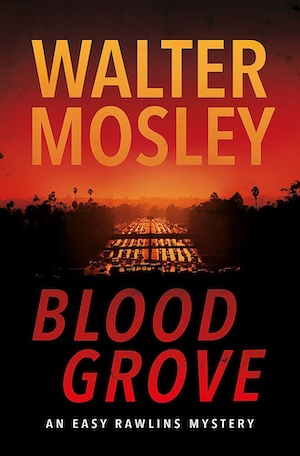
Blood Grove is the 15th novel in Walter Mosley’s hardboiled detective series featuring Ezekiel Porterhouse Rawlins, which began with Devil in a Blue Dress in 1990. Easy is an African American from Texas who fought in World War II and moved to Los Angeles after demobilising. By the time this novel opens in the summer of 1969, he has enough money to retire in comfort, drives a 1968 Rolls-Royce Phantom VI, lives in a gated community with his adopted daughter Feather, and owns the WRENS-L Detective Agency.
Easy is nonetheless suffering from an inexplicable ennui and pays for his secretary to take a holiday so that he can spend time in the office on his own. No sooner has she left than he is approached by a mentally disturbed Vietnam veteran named Craig Killian. The young white man thinks he stabbed a stranger to death while trying to rescue a woman in an orange grove in the San Fernando Valley. Killian lost consciousness in the struggle and when he came to both the woman and the body were gone. He wants Easy to find the woman and determine whether or not he killed the man.
Easy is neither convinced that the case is in his client’s interest nor that his client is being entirely truthful, but decides to take it because of their shared bond as combat veterans. He starts by visiting Killian’s mother, an ex-stripper named Lola who has maintained her contacts in organised crime, and suspects that she is implicated in either the deception or the case itself.
The mystery is deliciously complex, but proceeds at a leisurely pace, introducing several of Easy’s friends and associates and featuring a subplot concerning Feather’s biological family. Raymond ‘Mouse’ Alexander, his psychopathic childhood friend, assists him for a short time and Frank Sinatra has a walk-on part. Easy finds his first body about a third of the way through the narrative and realises that Killian is connected to an armoured car heist in San Bernadino.
Soon Easy is caught between characters that could not be more different, but are equally dangerous. Brock Oldstein is a gangster with a fearsome reputation, “From the extra-broad shoulders to his helmetlike bald head, from his hammer hands to the hairless and protruding eyebrows.” Donata Delphine, the woman Killian was trying to save, is a beautiful femme fatale of whom Easy is just as wary: “It felt like she was the child of evolution, a being who had mastered survival skills that most other human beings couldn’t even imagine.”
The action accelerates in the resolution, which is clever, tense, and unpredictable, with Mosley maintaining suspense until the very end, which circles back to where the novel began, with Easy’s curiosity about the hippie commune next door.
One of Mosley’s great skills as a writer of hardboiled detective fiction is the way in which he is able to link the past with the present. The Rawlins novels are set over two decades, from 1948 to 1969, but they are as much about America during the three decades in which they were published as they are about their historical context.
As an African American private detective, Easy is constantly harassed by the Los Angeles Police Department and is only able to prevent his encounters with them from resulting in detention or death by controlling his temper and directing the various officers to his high-ranking contact in the force. These encounters become so commonplace that there are times when Easy, who narrates the novel, simply notes that he lost 30 minutes of his life and doesn’t bother to provide the degrading – but potentially deadly – details. He quickly finds, for example, that his pleasure in driving the Phantom is completely outweighed by the extra attention it provokes, with every officer he drives past assuming the car is stolen.
Easy is also deeply suspicious of the Federal Bureau of Investigation, regarding them not as the clean-cut good guys of law enforcement, but the instrument of oppression of African Americans, particularly with respect to the radical movements of the 1960s. If you are aware of and concerned about these issues in the present, then you will experience déjà vu when reading this novel, which is one of reasons it is both a gripping crime story and so much more.
We interviewed Walter Mosley back in 2013. You can also select from a wide variety of detective fiction on our site here.
Weidenfeld & Nicolson
Print/Kindle/iBook
£9.99
CFL Rating: 5 Stars










I found the novel interesting, set in the milieu of Raymond Chandler territory. A thread running through the story was the narrator’s musings on his WW2 experiences. While not germane to the plot I do feel if referring to real events these should be accurate. In a reference to the liberation of Birkinau-Auschwitz he states this was carried out by US Army. It was, of course, the Red Army.